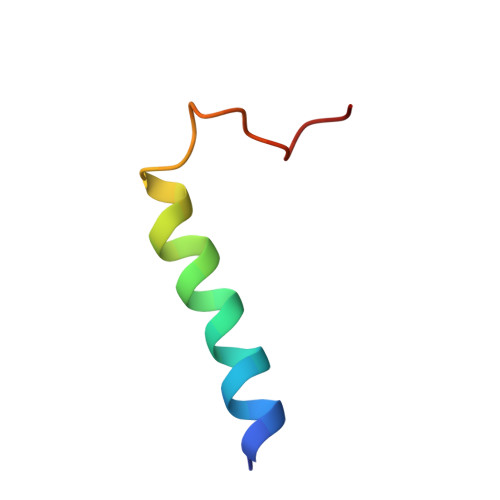The antimicrobial peptides casocidins I and II: Solution structural studies in water and different membrane-mimetic environments.
Mercurio, F.A., Scaloni, A., Caira, S., Leone, M.(2019) Peptides 114: 50-58
- PubMed: 30243923
- DOI: https://doi.org/10.1016/j.peptides.2018.09.004
- Primary Citation of Related Structures:
6FS4, 6FS5 - PubMed Abstract:
Antimicrobial peptides (AMPs) represent crucial components of the natural immune defense machinery of different organisms. Generally, they are short and positively charged, and bind to and destabilize bacterial cytoplasmic membranes, ultimately leading to cell death. Natural proteolytic cleavage of α s2 -casein in bovine milk generates the antimicrobial peptides casocidin I and II. In the current study, we report for the first time on a detailed structure characterization of casocidins in solution by means of Nuclear Magnetic Resonance spectroscopy (NMR). Structural studies were conducted in H 2 O and different membrane mimetic environments, including 2,2,2-trifluoroethanol (TFE) and lipid anionic and zwitterionic vesicles. For both peptides, results indicate a mainly disordered conformation in H 2 O, with a few residues in a partial helical structure. No wide increase of order occurs upon interaction with lipid vesicles. Conversely, peptide conformation becomes highly ordered in presence of TFE, with both casocidins presenting a large helical content. Our data point out a preference of casocidins to interact with model anionic membranes. These results are compatible with possible mechanisms of action underlying the antimicrobial activity of casocidins that ultimately may affect membrane bilayer stability.
- Institute of Biostructures and Bioimaging (IBB), National Research Council & Interuniversity Research Centre on Bioactive Peptides (CIRPEB), Via Mezzocannone 16, 80134 Naples, Italy.
Organizational Affiliation:
















